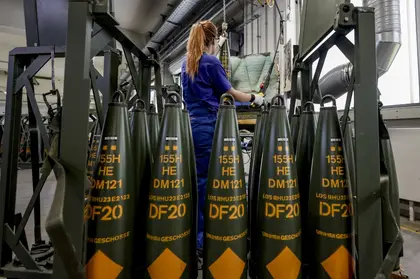The German arms manufacturer Rheinmetall announced it has received another hard order for something north of 100,000 needed 155mm artillery shells for the Ukrainian military, as Europe’s armaments sector made a rare tangible step toward the production of the critical munition in industrial quantities.
An Oct. 10 Rheinmetall Waffe Munition GmbH corporate announcement said the Düsseldorf-headquartered firm had booked an order from the German Bundeswehr for the shells’ delivery in 2023 and 2024, with “tens of thousands” of rounds to be produced in coming months.
JOIN US ON TELEGRAM
Follow our coverage of the war on the @Kyivpost_official.
Rheinmetall’s Spanish subsidiary will produce the contracted NATO-standard shells at around €3,000 a unit. Funding for the manufacturing will come from a July 2023 Bundeswehr commitment to purchase at least €1.2 billion worth of 155mm shells from Rheinmetall over the next six years, company spokesman Oliver Hoffman told Kyiv Post.
The October purchase order was the third thus far made by the Bundeswehr in the long-term artillery ammunition purchasing arrangement with Rheinmetall. The contracts encompass the delivery of shells, fuses and propelling charges, and some of the rounds set to be received by the Ukrainians will be the DM121 shell, a modern munition designed to extend the range of NATO-standard howitzers out to 30 km.
Deadly accurate and out-ranging practically all Russian tube artillery, the 155mm howitzer shell is the backbone of the Armed Forces of Ukraine’s (AFU) battlefield firepower and by many accounts, the single most important munition delivered to Ukraine by its Western allies since the Russian full-scale invasion in February 2022.

The Struggle to Save Ukraine’s Children on the Front
The first towed 155mm howitzers arriving in Ukraine in May 2022 in battles around the town of Lyman and adjacent crossing sites of the Siviersky Donets River were instrumental in stopping cold the Russian army’s last large-scale attempt in the war to gain ground quickly with massed armor.
By late summer 2023, thanks to superior ammunition and more accurate cannon, Ukrainian artillery, using primarily the 155mm round, was able in most engagements to shoot and destroy Russian artillery from well outside ranges Russian gunners were able to retaliate.
In fighting around the town Avdiivka near the city Donetsk, since Monday, drone-controlled 155mm artillery strikes have reportedly devastated recent Russian army attempts to regain initiative in that sector, destroying more than 90 armored vehicles in the most recent 24 hours of fighting alone, field reports from units in the battle said.
AFU spokespersons have warned that the Ukrainian military’s demand for the popular 155mm munition is nearly bottomless. According to unofficial estimates, in a typical day of fighting across the Russo-Ukraine war’s 1,500-kilometer front line, AFU gunners likely fire off about 2,000 155mm shells at Russian troop targets, weapons and military infrastructure – but AFU reconnaissance generally finds three or four times more targets than there are shells to hit them with.
Pro-rated over the next fifteen months – and not counting shells delivered to Ukraine in other Rheinmetall tranches or by other manufacturers – the Oct. 10 Bundeswehr order planning to help Kyiv’s forces with 155mm ammunition, will probably add 200-250 155mm shells a day to overall AFU artillery ammunition reserves, Kyiv Post research found.
Troels Lund Poulsen, Minister of Defense of Denmark, on Sept. 20 announced his government had finalized plans to purchase a mothballed 155mm artillery shell plant in the town Elling, near the city Frederikshavn.
The Ammunitionsarsenalet plant manufactured the shell for Denmark’s and other NATO armies until 1968 and at peak production employed up to 200 workers. In 2008, the Danish state sold the factory to the Spanish ammunition manufacturer Expal, which used the site primarily to produce rifle ammunition and to destroy old artillery ammunition no longer needed by European post-Cold War armies. Business was worse than expected and in 2020 the Spanish owner shut down the plant. At the time, 65 people worked there, Danish news reports said.
Poulsen in a statement said that his government was moving to acquire firms like the Ammunitionsarsenalet plant to create vertically integrated artillery ammunition production in Denmark and to fill NATO’s growing need for deep reserves of 155mm shells.
“If we can create a model in which the armed forces can intervene and facilitate the acquisition of buildings and force private companies to produce products, I believe that within the next few years we will be able to produce ammunition in Denmark,” Poulsen said.
According to Oct. 2 reports in Danish and Ukrainian media, the Danish government paid $14.2 million (100 million Danish kroner) to purchase the Ellig factory, using funding from a European Defense Agency (EDA) joint ammunition procurement project set to run over the next eight years.
Denmark was admitted as an EDA member on Mar. 23, 2023. Within days senior Copenhagen officials led by Poulsen announced their government was considering taking over the plant to produce the ammo as an EDA contractor.
According to a Sep. 5 EDA announcement, the Agency has at that time signed eight framework contracts with European industry for the joint procurement of 155mm ammunition.
EDA Head Josep Borrell was quoted as saying: “We are taking another step forward in our three-track ammunition initiative. Member States can now pass orders within eight framework contracts. Time is of the essence. Putin does not show any sign of letting up in his aggression against the Ukrainian people. This is why our military support for Ukraine’s defense must continue.”
It was not clear in October when Danish 155mm shell production actually would start.
You can also highlight the text and press Ctrl + Enter






